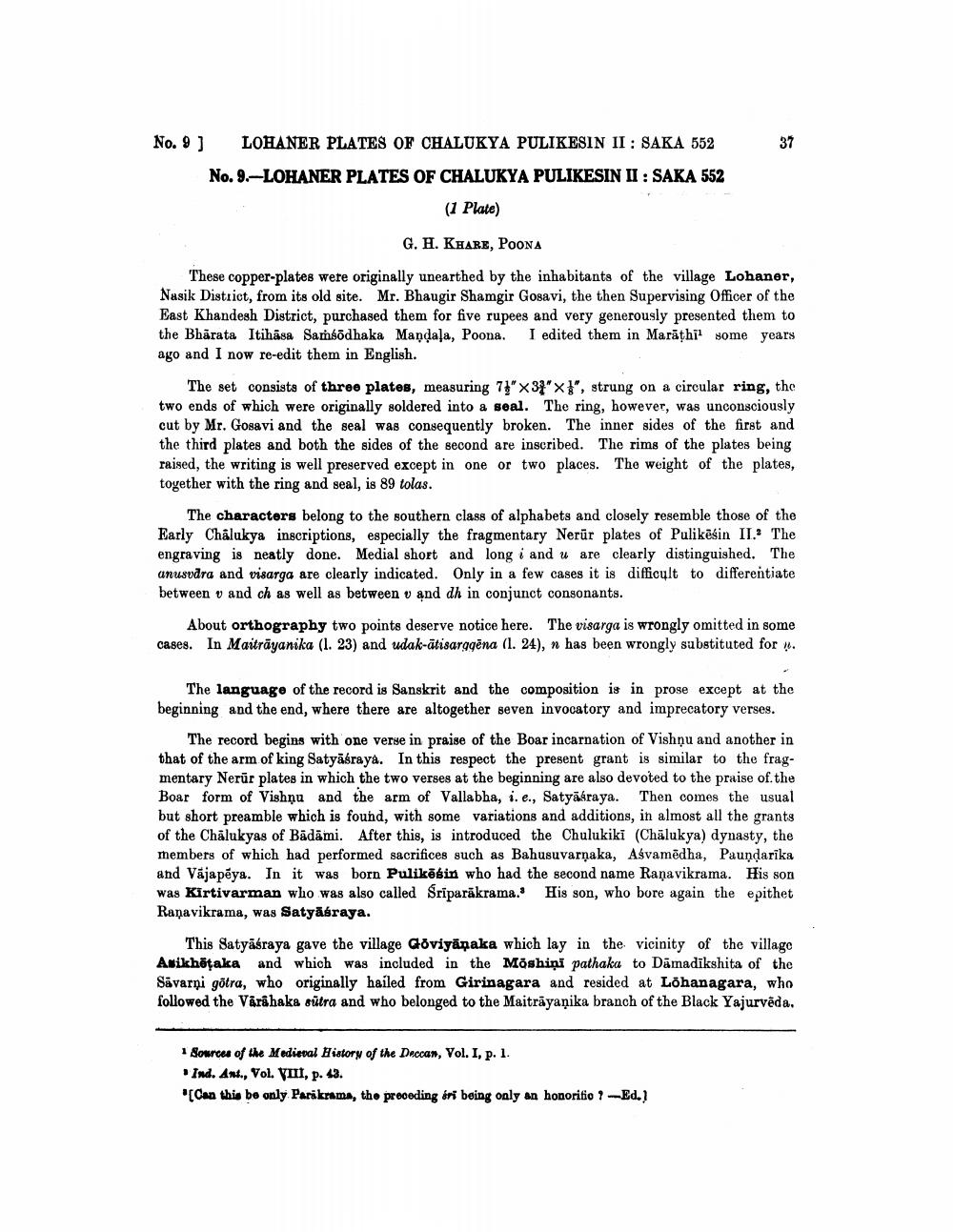________________
No. 9 ) LOHANER PLATES OF CHALUKYA PULIKESIN II : SAKA 552 No. 9.–LOHANER PLATES OF CHALUKYA PULIKESIN II : SAKA 552
(1 Plate) G. H. KHARE, POONA
These copper-plates were originally unearthed by the inhabitants of the village Lohaner, Nasik District, from its old site. Mr. Bhaugir Shamgir Gosavi, the then Supervising Officer of the East Khandesh District, purchased them for five rupees and very generously presented them to the Bhārata Itihāsa Samsodhaka Mandala, Poona. I edited them in Marāthit some years ago and I now re-edit them in English.
The set consists of three plates, measuring 71" x 34" x}", strung on a circular ring, the two ends of which were originally soldered into a seal. The ring, however, was unconsciously cut by Mr. Gosavi and the seal was consequently broken. The inner sides of the first and the third plates and both the sides of the second are inscribed. The rims of the plates being raised, the writing is well preserved except in one or two places. The weight of the plates, together with the ring and seal, is 89 tolas.
The characters belong to the southern class of alphabets and closely resemble those of the Early Chalukya inscriptions, especially the fragmentary Nerür plates of Pulikēsin II. The engraving is neatly done. Medial short and long i and u are clearly distinguished. The anusudra and visarga are clearly indicated. Only in a few cases it is difficult to differentiate between v and ch as well as between v and dh in conjunct consonants.
About orthography two points deserve notice here. The visarga is wrongly omitted in some cases. In Maitrāyanika (1. 23) and udak-ātisarggēna (l. 24), n has been wrongly substituted for y.
The language of the record is Sanskrit and the composition is in prose except at the beginning and the end, where there are altogether seven invocatory and imprecatory verses.
The record begins with one verse in praise of the Boar incarnation of Vishņu and another in that of the arm of king Satyāśraya. In this respect the present grant is similar to the fragmentary Nerūs plates in which the two verses at the beginning are also devoted to the praise of the Boar form of Vishnu and the arm of Vallabha, i.e., Satyasraya. Then comes the usual but short preamble which is found, with some variations and additions, in almost all the grants of the Chalukyas of Bādāmi. After this, is introduced the Chulukiki (Chālukya) dynasty, the members of which had performed sacrifices such as Bahusuvarņaka, Asvamēdha, Paundarika and Vajapēya. In it was born Pulikēsin who had the second name Raņavikrama. His son was Kirtivarman who was also called Sriparākrama. His son, who bore again the epithet Ranavikrama, was Satyāśraya.
This Satyasraya gave the village Goviyāņaka which lay in the vicinity of the village Asikhötaka and which was included in the Möshiņi pathaka to Dāmadikshita of the Sävarņi götra, who originally hailed from Girinagara and resided at Lohanagara, who followed the Värähaka sutra and who belonged to the Maitrāyaṇika branch of the Black Yajurvēda,
1 Source of the Medieval History of the Daccan, Vol. I, p. 1. . Ind. Ant., Vol. VIII, p. 43. (Can this be only Parikrama, the preceding éri being only an honoritio 1 -Ed.)




